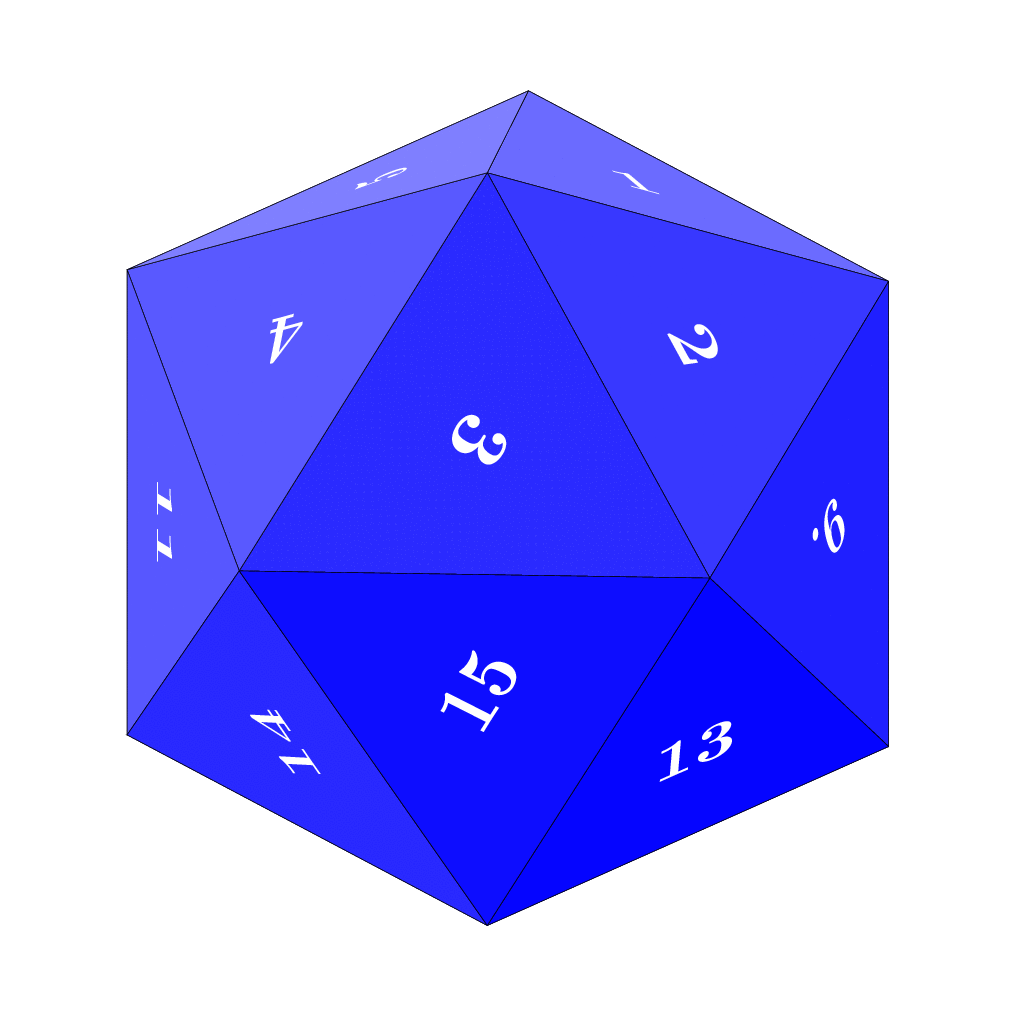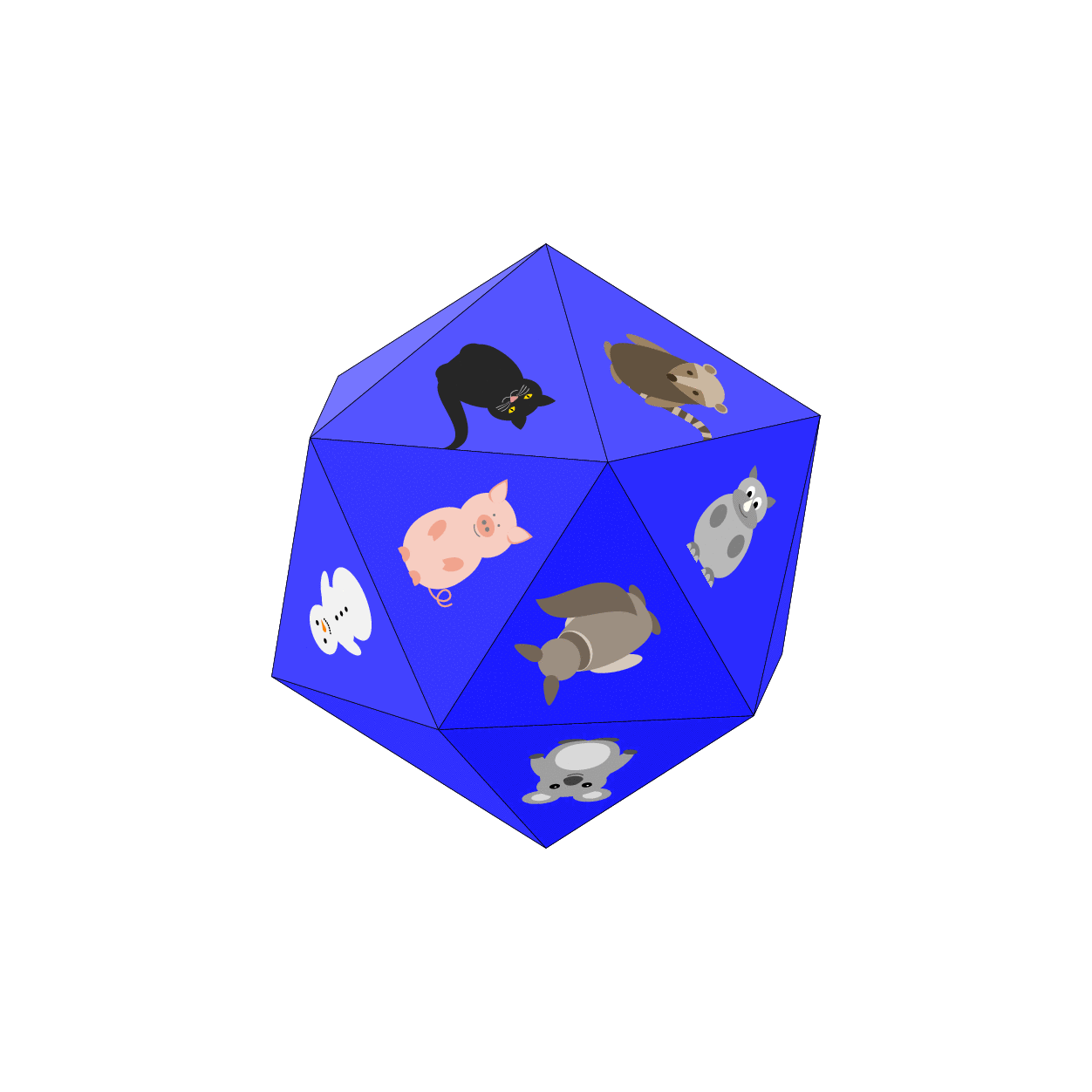Thanks to the [Mathematica code that you linked to](https://mathematica.stackexchange.com/a/55250) one can order the faces in such a way that the numbering is realistic. Some time ago I wrote some code that allows one to draw arbitrary polyhedra for arbitrary view angles with Ti*k*Z. You will need the inofficial [3dtools library](https://github.com/marmotghost/tikz-3dtools) since this code computes quite a few vector products, linear combinations and projections, which are, to the best of my knowledege, not supported by the official Ti*k*Z libraries. This works by getting the vertices and polygons bounding the faces from somewhere. One possibility is to use Mathematica with the commands (in the case at hand we want an icosahedron)
```
PolyhedronData["Icosahedron", "VertexCoordinates"]
PolyhedronData["Icosahedron", "FaceIndices"]
```
(but for the purpose of the first code I used [this link](https://mathematica.stackexchange.com/a/55250) to have opposite numbers adding up to 21) and feeding them into some otherwise identical routine, draws the faces in such a way that the "visible" ones are in the foreground and the hidden ones in the background. The visibility is decided according whether the outward-facing normal of a given polyon point out of or into the screen. These projections are computed in a "tool-independent" way, i.e. even though `tikz-3dplot` is used to define the view angles, any other tool will also work. It also manually cures some `dimension too large` errors that in the best of all worlds are taken care of already at the level of the `3d` library. They would emerge if the projection of the plane becomes so thin that the number is not readable (or even visible) anyway. This is something that definitely needs to be improved, possibly at the expense of rewriting parts of the `3d` library.
```
\documentclass[tikz,border=3mm]{standalone}
\usepackage{tikz-3dplot}
\usetikzlibrary{backgrounds,3dtools} % https://github.com/marmotghost/tikz-3dtools
\makeatletter
\tikzset{use fpu reciprocal/.code={%
\def\pgfmathreciprocal@##1{%
\begingroup
\pgfkeys{/pgf/fpu=true,/pgf/fpu/output format=fixed}%
\pgfmathparse{1/##1}%
\pgfmath@smuggleone\pgfmathresult
\endgroup
}}}%
\makeatother
\tikzset{pics/icosahedron/.style={code={
\path foreach \Coord [count=\X] in
{(0, -1, -PHI), (0, -1, +PHI), (0, +1, -PHI), (0, +1, +PHI),
(-1, -PHI, 0), (-1, +PHI, 0), (+1, -PHI, 0), (+1, +PHI, 0),
(-PHI, 0, -1), (+PHI, 0, -1), (-PHI, 0, +1), (+PHI, 0, +1)}
{\Coord coordinate (p\X) \pgfextra{\xdef\NumVertices{\X}}};
%\message{number of vertices is \NumVertices^^J}
% "light source"
\edef\lstPast{0}
\foreach \poly [count=\iface] in
{{2, 4, 12},
{2, 12, 7},
{2, 7, 5},
{2, 5, 11},
{2, 11, 4},
{4, 6, 8},
{4, 8, 12},
{4, 6, 11},
{12, 7, 10},
{12, 8, 10},
{11, 9, 5},
{11, 9, 6},
{1, 7, 10},
{1, 9, 5},
{1, 7, 5},
{1, 3, 10},
{8, 3, 10},
{6, 3, 8},
{3, 9, 6},
{1, 3, 9}}
{
\pgfmathtruncatemacro{\ione}{{\poly}[0]}
\pgfmathtruncatemacro{\itwo}{{\poly}[2]}
\pgfmathtruncatemacro{\ithree}{{\poly}[1]}
\path[overlay,3d coordinate={(dA)=(p\itwo)-(p\ione)},
3d coordinate={(dB)=(p\itwo)-(p\ithree)},
3d coordinate={(nA)=(dA)x(dB)}] ;
\pgfmathtruncatemacro{\jtest}{sign(TD("(nA)o(p\ione)"))}
% make sure that the normal points outwards
\ifnum\jtest<0
\path[overlay,3d coordinate={(nA)=(dB)x(dA)}];
\else % change the orientation of the basis vectors
\edef\idum{\ithree}%
\edef\ithree{\itwo}%
\edef\itwo{\idum}%
%\typeout{reordered \iface}
\fi
% barycenter for triangular faces
\pgfmathsetmacro{\mybary}{TD("0.333*(p\ione)+0.333*(p\itwo)+0.333*(p\ithree)")}
\path[overlay] (\mybary) coordinate (bary-\iface);
% compute projection the normal of the polygon on the normal of screen
\pgfmathsetmacro{\mynA}{TD("(nA)")}
\pgfmathsetmacro\myproj{screendepth(\mynA)}
\pgfmathsetmacro\lproj{TD("(nA)o(L)")/3}
\pgfmathtruncatemacro{\itest}{sign(\myproj)}
\pgfmathtruncatemacro{\cf}{70-25*\lproj}% color fraction between 50 and 90
\ifnum\itest>-1
\draw[ultra thin] [fill=mypolyhedroncolor!\cf]
plot[samples at=\poly,variable=\x](p\x) -- cycle;
\path[3d/define orthonormal dreibein={A={(p\ione)},B={(p\itwo)},C={(p\ithree)}}];
\path let \p1=(ex),\p2=(ey),
\n1={min(veclen(\x1,\y1),veclen(\x2,\y2))},
\n2={abs(\x1*\x2+\y1*\y2)},
\n3={(\n1>3)+(\n2<333)}
in \pgfextra{\pgfmathtruncatemacro{\myflag}{\n3}\xdef\myflag{\myflag}};
\ifnum\myflag=2% <- make sure that the plane is not too weird
\begin{scope}[x={(ex)},y={(ey)},z={(ez)},canvas is xy plane at z=0]
\path (bary-\iface) node[transform shape,text=white,
font=\bfseries]{\FaceNum{\iface}};
\end{scope}
\fi
\else
\begin{scope}[on background layer]
\draw[gray,ultra thin] [fill=mypolyhedroncolor!\cf!black]
plot[samples at=\poly,variable=\x](p\x) -- cycle;
\end{scope}
\fi
}}}}
% this controls the number
\newcommand\FaceNum[1]{\ifcase#1\or
1\or2\or3\or4\or5\or6.\or7\or8\or9.\or10\or
11\or12\or13\or14\or15\or16\or17\or18\or19\or20\fi}
\begin{document}
\foreach \Angle in {5,15,...,355}
{\tdplotsetmaincoords{70+10*cos(\Angle)}{\Angle}
\begin{tikzpicture}[tdplot_main_coords,line cap=round,line join=round,
declare function={PHI=(1+sqrt(5))/2;}]
\path[tdplot_screen_coords,use as bounding box] (-4,-4) rectangle (4,4);
% light source
\path[overlay] ({-sqrt(1/6)},{sqrt(3/6)},{sqrt(2/6)}) coordinate (L);
% base color
\colorlet{mypolyhedroncolor}{blue}
% draw the d20
\path[scale=2,transform shape] pic{icosahedron};
\end{tikzpicture}}
\end{document}
```

I tried to explain things like the "light source" or the color in the code.
And here is an alternative with major support by our Ti*k*Zlings.
```
\documentclass[tikz,border=3mm]{standalone}
\usepackage{tikzlings}
\newcommand{\Diceling}[2][]{%
\ifcase#2
\anteater[#1]\or
\bear[#1]\or
\bee[#1]\or
\cat[#1]\or
\coati[#1]\or
\hippo[#1]\or
\koala[#1]\or
\marmot[#1]\or
\squirrel[back,#1]\or
\mouse[#1]\or
\owl[#1]\or
\panda[#1]\or
\penguin[#1]\or
\pig[#1]\or
\rhino[#1]\or
\squirrel[#1]\or
\anteater[back,#1]\or
\bear[back,#1]\or
\bee[back,#1]\or
\koala[back,#1]\or
\snowman[#1]\or
\fi}
\usepackage{tikz-3dplot}
\usetikzlibrary{backgrounds,3dtools} % https://github.com/marmotghost/tikz-3dtools
%\newcounter{tdorder}
\tikzset{pics/icosahedron/.style={code={
\path foreach \Coord [count=\X] in
{(0., 0., -0.9510565162951536),
(0., 0., 0.9510565162951536), (-0.85065080835204,
0., -0.42532540417601994), (0.85065080835204, 0.,
0.42532540417601994), (0.6881909602355868, -0.5,
-0.42532540417601994), (0.6881909602355868, 0.5,
-0.42532540417601994), (-0.6881909602355868, -0.5,
0.42532540417601994), (-0.6881909602355868, 0.5,
0.42532540417601994), (-0.2628655560595668,
-0.8090169943749475, -0.42532540417601994),
(-0.2628655560595668, 0.8090169943749475,
-0.42532540417601994), (0.2628655560595668,
-0.8090169943749475, 0.42532540417601994),
(0.2628655560595668, 0.8090169943749475,
0.42532540417601994)}
{\Coord coordinate (p\X) \pgfextra{\xdef\NumVertices{\X}}};
%\message{number of vertices is \NumVertices^^J}
% "light source"
\edef\lstPast{0}
\foreach \poly [count=\iface] in
{{2, 12, 8}, {2, 8, 7}, {2, 7, 11}, {2, 11, 4},
{2, 4, 12}, {5, 9, 1}, {6, 5, 1}, {10, 6, 1},
{3, 10, 1}, {9, 3, 1}, {12, 10, 8}, {8, 3, 7},
{7, 9, 11}, {11, 5, 4}, {4, 6, 12}, {5, 11, 9},
{6, 4, 5}, {10, 12, 6}, {3, 8, 10}, {9, 7, 3}}
{
\pgfmathtruncatemacro{\ione}{{\poly}[0]}
\pgfmathtruncatemacro{\itwo}{{\poly}[1]}
\pgfmathtruncatemacro{\ithree}{{\poly}[2]}
\path[overlay,3d coordinate={(dA)=(p\itwo)-(p\ione)},
3d coordinate={(dB)=(p\itwo)-(p\ithree)},
3d coordinate={(nA)=(dA)x(dB)}] ;
\pgfmathtruncatemacro{\jtest}{sign(TD("(nA)o(p\ione)"))}
% make sure that the normal points outwards
\ifnum\jtest<0
\path[overlay,3d coordinate={(nA)=(dB)x(dA)}];
\fi
% barycenter for triangular faces
\pgfmathsetmacro{\mybary}{TD("0.333*(p\ione)+0.333*(p\itwo)+0.333*(p\ithree)")}
\path[overlay] (\mybary) coordinate (bary-\iface);
% compute projection the normal of the polygon on the normal of screen
\pgfmathsetmacro{\mynA}{TD("(nA)")}
\pgfmathsetmacro\myproj{screendepth(\mynA)}
\pgfmathsetmacro\lproj{TD("(nA)o(L)")}
\pgfmathtruncatemacro{\itest}{sign(\myproj)}
\pgfmathtruncatemacro{\cf}{70-25*\lproj}% color fraction between 50 and 90
\ifnum\itest>-1
\draw[ultra thin] [fill=mypolyhedroncolor!\cf]
plot[samples at=\poly,variable=\x](p\x) -- cycle;
\path[3d/define orthonormal dreibein={A={(p\ione)},B={(p\itwo)},C={(p\ithree)}}];
\path let \p1=(ex),\p2=(ey),\p3=(ez),
\n1={min(veclen(\x1,\y1),veclen(\x2,\y2),veclen(\x3,\y3))},
\n2={abs(\x1*\x2+\y1*\y2)},
\n3={(\n1>2)+(\n2<320)}
in \pgfextra{\pgfmathtruncatemacro{\myflag}{\n3}\xdef\myflag{\myflag}};
\ifnum\myflag=2% <- make sure that the plane is not too weird
\begin{scope}[x={(ex)},y={(ey)},z={(ez)},canvas is xy plane at z=0,
scale=0.2,shift={(bary-\iface)},shift={(0,-1)}]
\Diceling{\iface}
\end{scope}
\fi
\else
\begin{scope}[on background layer]
\draw[gray,ultra thin] [fill=mypolyhedroncolor!\cf!black]
plot[samples at=\poly,variable=\x](p\x) -- cycle;
\end{scope}
\fi
}}}}
\begin{document}
\foreach \Angle in {5,15,...,355}
{\tdplotsetmaincoords{70+9*cos(\Angle)}{\Angle}
\begin{tikzpicture}[tdplot_main_coords,line cap=round,line join=round]
\path[tdplot_screen_coords,use as bounding box] (-5,-5) rectangle (5,5);
% light source
\path[overlay] ({-sqrt(1/6)},{sqrt(3/6)},{sqrt(2/6)}) coordinate (L);
% base color
\colorlet{mypolyhedroncolor}{blue}
% draw the d20
\path[scale=pi,transform shape] pic{icosahedron};
\end{tikzpicture}}
\end{document}
```
